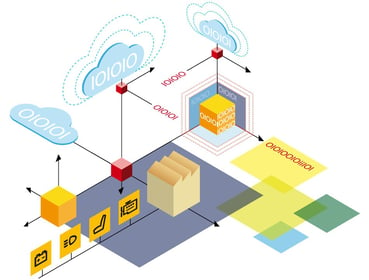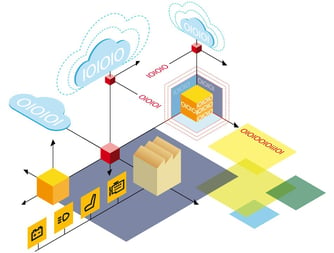4 Surprising Uses for Real-time Information in the Supply Chain
Brian Hoey - August 30, 2018

 In the past five to 10 years, real-time information has become a key value-added proposition for bolstering efficiency and decreasing waste in modern, digital supply chains. Businesses have used it to power more agile, responsive processes within their own value streams, creating environments that are primed for improved data-quality and easier analytics integration. The question remains, however, is this technology being utilized to its maximum effect, or are there still use-cases for real-time information that most businesses are failing to fully leverage? The answer is resoundingly the latter, as evidenced by these four surprising uses for real-time supply chain data.
In the past five to 10 years, real-time information has become a key value-added proposition for bolstering efficiency and decreasing waste in modern, digital supply chains. Businesses have used it to power more agile, responsive processes within their own value streams, creating environments that are primed for improved data-quality and easier analytics integration. The question remains, however, is this technology being utilized to its maximum effect, or are there still use-cases for real-time information that most businesses are failing to fully leverage? The answer is resoundingly the latter, as evidenced by these four surprising uses for real-time supply chain data.
1. Inventory and Freight Optimization
The beauty of real-time integration is that it ensures that businesses have the most up-to-date possible information when it comes time to make a decision. One area in which this benefit yields especially potent results in inventory management. By taking in real-time data about orders placed and fulfilled as you make final decisions on how to best utilize your limited storage space in both warehouses and trucks, you can help decrease the likelihood that items will be stocked or shipped only to go unsold or unused. In this way, it’s possible not just to save on the cost of transporting goods, but to drive towards an agile-lean inventory process that will make your use of space more efficient in the long run. As you’re able to get ever more granular insights up to the last moments before goods need to be moved, you’ll ultimately be able to affect a long-term reduction in inventory levels, thereby saving even more space and resources.
2. Event Based Early Warnings
It’s commonly known that real-time supply chain information can be used to gain up-to-the-minute insight into current demand levels, accounting for slowdowns or upticks as they unfold. Less commonly known, however, is that real-time insights can serve as the foundation for an entire early warning system for supply chain events. By utilizing a model that gathers inter-organizational data from suppliers, partners, and other sources, it’s possible to gain value from a system that alerts you to unexpected supply chain situations like weather changes, late deliveries, rerouted shipments and other events that might combine to impact your own operations. Instead of having to reimagine your production plans on the fly only after things have gone wrong, it’s possible to make adjustments in advance of any impending bottleneck or breakdowns. This way, you can retain the maximum amount of value in situations that might otherwise blindside you.
3. Better Customer Service
Most of the focus when it comes to real-time has been on ways to improve adaptability and flexibility within a given company’s production plans. What many fail to realize, however, is that it can also be a powerful tool for bolstering customer satisfaction. How exactly does it accomplish this? Simply put, because real-time supply chain information requires a high degree of visibility in order to operationalize in the first place, making this same information visible to your customers as well is a fairly straightforward next step. By giving customers the ability to track expected shipments in real-time, you give them the confidence to plan ahead knowing that they will be able to pinpoint the precise moment at which their desired goods will arrive. In doing so, you add value for them not just in the shape of products or parts provided, but in the form of smoother, more stable workflows on their end. Not only that, but providing this information for your customers can help to elevate the level of trust that they have in your business, leading to a stronger, potentially more collaborative relationship going forward.
4. Improved Planning Integration
So far, we’ve covered some of the ways that real-time information can increase the agility and adaptability of your production plans. Creating a more responsive production environment, however, is just the tip of the iceberg in terms of the effects that real-time can have on your preexisting planning workflows. By using up-to-the-minute demand and transport information to power a sales & operations execution (S&OE) process, you can actually create new levels of cohesion between the various levels of your planning funnel and your day-to-day supply chain operations. Essentially, S&OE can bridge the gap between mid-term sales & operations planning (S&OP) and daily operations in a way that can help keep longer term plans on track. By making small, minute adjustments to inventory levels and transport logistics, S&OE can create an environment in which longer-term plans aren’t blindsided by disruptions, thus creating a more cohesive, less siloized planning structure. In this way, we can see S&OE and even real-time itself as important hallmarks of Industry 4.0's rise in modern manufacturing.
LATEST POSTS
- Understand Circular Economy in The Manufacturing Industry
- How Can Industry 4.0 IT Integration Be Achieved Smoothly?
- The Significance of Order Sequencing in Discrete Manufacturing
- How to improve your Supply Chain Management: The Power of Control Towers
- Optimizing Human Resource Scheduling in Manufacturing: A Technological Approach



